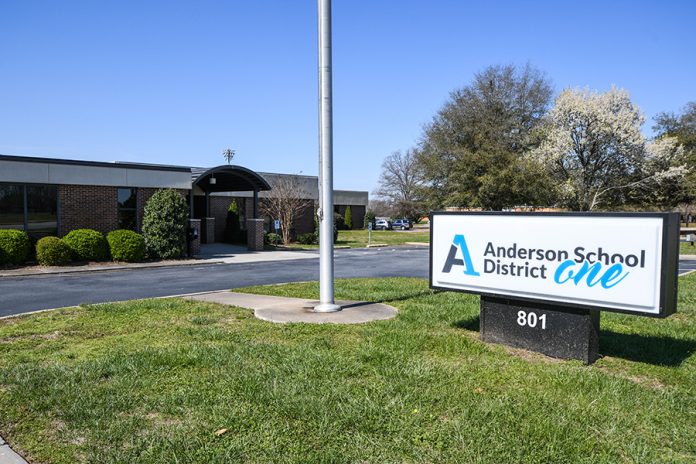By David Meade
Anderson School District One Superintendent David Havird presented preliminary 2018-19 budget information to the School Board Tuesday.
Havird said the budget, based on the Senate version of the state budget, is “a very accurate version of a first draft” but added that it could change.
During the presentation, Havird said that the budget is more than just revenues and expenditures.
“It is a thoughtful expression of the education experiences our students need in order to be prepared.”
“The road to a prosperous future begins for each of our students at the school house doors,” Havird said. He said the budget meets the Board goal – “To create and oversee a fiscally responsible budget that upholds the mission and values of our communities.”
Before getting into the details of the budget, the presentation reflected on achievements and results from previous investment in School District One including: A 92 percent graduation rate; AdvancED accreditation for all fourteen schools and district office; District One being among the top ten school districts in nearly every academic category; Digital innovation; Advance placement/dual credit; Twenty programs of study at the Career & Technology Center; Standard-based profession development for teachers, A state champion Robotics team that will be competing on a national level in Louisville, and Debt Free Construction Projects through the Local Option Sales Tax funding.
The budget shows anticipated revenues and expenses of $74,647,387, an increase of $2.5 million over the current budget. Havird described the budget as “conservative.”
According to Havird, the Senate verson of the budget shows some changes in funding for EFA, Teacher Pay, and School buses.
The biggest change affecting local school districts is that the senate version raises the student base cost to $2,485, which is $60 per studnet more than the current $2,425.
The senate budget reduces the teacher pay increase to one percent while the house version is at two percent.
It also provides $10 million increase for buses, while the house adds $8 million.
General revenue for the District One budget, using the base student cost of $2,485, will result in revenues of $26,814,010.
State revenue sources include Property Tax Relief – Tier 1 $1,720,606; Homestead Exemption – Tier 2 $696,500; Act 388 Reimbursement – Tier 3 $6,554,200 (increase of $262,470); Merchants Inventory $44,300; Manufacturing Depreciation Reimbursement $415,000; Motor Carrier Other State Taxes $100,000; and Reading Coaches $353,258.
The State also provides continuing revenue for State Employer Contributions for Retirement and Health insurance of $11,714,933. This is an increase of $319,480 for one percent employer retirement increase and a 4.7 percent employer health insurance increase.
EIA Teacher Salary Supplement Fringe amounts to $388,619. This is an increase of $140,342 to cover the one percent retirement increase.
The state funding increases only cover a portion of the mandated increases in retirement and health and the District will cover the rest.
Based on a CPI of 2.13 percent increase and a Population Growth increase in the District of 2.24 percent, District One is allowed a 4.37 percent millage increase under Act 388.
Act 388 limits that amount of an increase based on a formula using the Consumer Price Index (CPI) and Population growth in the district.
If the board approves the millage rate increase, the current rate of 147 will go to 153.4. The change will generate $714,170 in revenue for the District.
The millage increase will allow the District to add professional staff for student growth, expected to see an increase of 150 to 200 new students, provide four additional school resource officers and help balance the budget.
Havird said the state average for operating mills is 182. District One also has a per pupil expenditure of $9,946 compared to the state average of $12,965.
He also pointed out that District One usually ranks in the top ten of eighty-one school districts in academic performance.
District One is expecting a 1.5 percent increase in enrollment, which will result in the need for 9.5 additional professional staff and 5.5 support staff.
The budget also adds $210,000 for four additional School Resource Officers, putting a “trained, armed SRO in every school in the District,” Havird said. He added that feedback shows this is “the most proactive and effective way to prevent future school tragedies.”
Havird pointed out that if the state provided funding required according to the EFA formula, the base student cost would be $3,018 instead of the projects BSC of $2,485, resulting in an additional $533 per student. For Anderson District One that amounts to an additional $5,751,000.
On the expense side, Personnel Salaries and Benefits amount to $63,053,330; Purchased Services $4,698,274; Supplies and Materials $3,676,434; Capital Outlay (Equipment) $2,414,075; Other Expenses $232,275 and Transfers $573,000. Anticipated budget total expenditures of $74,647,387.
(Additional details of the budget and how it affects each school will be addressed in a future news article in The Journal.)


















